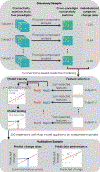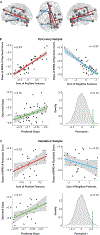A Functional Connectome-Based Neural Signature for Individualized Prediction of Antipsychotic Response in First-Episode Psychosis
- PMID: 37644811
- PMCID: PMC11104773
- DOI: 10.1176/appi.ajp.20220719
A Functional Connectome-Based Neural Signature for Individualized Prediction of Antipsychotic Response in First-Episode Psychosis
Abstract
Objective: Identification of robust biomarkers that predict individualized response to antipsychotic treatment at the early stage of psychotic disorders remains a challenge in precision psychiatry. The aim of this study was to investigate whether any functional connectome-based neural traits could serve as such a biomarker.
Methods: In a discovery sample, 49 patients with first-episode psychosis received multi-paradigm fMRI scans at baseline and were clinically followed up for 12 weeks under antipsychotic monotherapies. Treatment response was evaluated at the individual level based on the psychosis score of the Brief Psychiatric Rating Scale. Cross-paradigm connectivity and connectome-based predictive modeling were employed to train a predictive model that uses baseline connectomic measures to predict individualized change rates of psychosis scores, with model performance evaluated as the Pearson correlations between the predicted change rates and the observed change rates, based on cross-validation. The model generalizability was further examined in an independent validation sample of 24 patients in a similar design.
Results: The results revealed a paradigm-independent connectomic trait that significantly predicted individualized treatment outcome in both the discovery sample (predicted-versus-observed r=0.41) and the validation sample (predicted-versus-observed r=0.47, mean squared error=0.019). Features that positively predicted psychosis change rates primarily involved connections related to the cerebellar-cortical circuitry, and features that negatively predicted psychosis change rates were chiefly connections within the cortical cognitive systems.
Conclusions: This study discovers and validates a connectome-based functional signature as a promising early predictor for individualized response to antipsychotic treatment in first-episode psychosis, thus highlighting the potential clinical value of this biomarker in precision psychiatry.
Keywords: Biomarkers; Connectome; Neuroimaging; Schizophrenia Spectrum and Other Psychotic Disorders.
Conflict of interest statement
Dr. Gallego has served as a speaker for Tecnoquimicas. Dr. Rubio has served as a consultant for Janssen, Karuna, and TEVA, has received research funding from Alkermes, and has received royalties from UpToDate. Dr. Birnbaum has served as a consultant for Northshore Therapeutics and HearMe. Dr. Robinson has served as a consultant for Acadia, Advocates for Human Potential, Amalyx, APA, C4 Innovations, Costello Medical Consulting, Health Analytics, Innovative Science Solutions, Janssen, Lundbeck, Neurocrine, Neuronix, Otsuka, Teva, and US WorldMeds and has received grant support from Otsuka. Dr. Malhotra has served as a consultant for Acadia Pharma, Clarivate, Genomind, Health Advances, InformedDNA, Iqvia, and Janssen Pharma. The other authors report no financial relationships with commercial interests.
Figures



Comment in
-
Another Step Toward the Prediction of Antipsychotic Treatment Response Using Functional Connectivity.Am J Psychiatry. 2023 Nov 1;180(11):787-788. doi: 10.1176/appi.ajp.20230731. Am J Psychiatry. 2023. PMID: 37908095 No abstract available.
References
-
- Emsley R, Chiliza B, Schoeman R: Predictors of long-term outcome in schizophrenia. Curr Opin Psychiatry 2008; 21:173–177 - PubMed
Publication types
MeSH terms
Substances
Grants and funding
LinkOut - more resources
Full Text Sources
Medical

